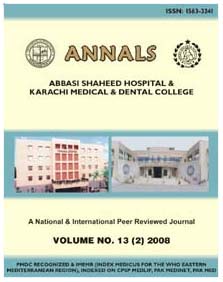
| |
| Home |
| Editorial Staff |
| Instruction to Authors |
| Journal-Issues |
| Policy |
| Newsletter |
| Copyright |
| DERMATOPHYTES CAUSING TINEA CRURIS IN OUR POPULATION
MUHAMMAD SABIR, SALEEM AHMED KHARAL, SHAIKH SAJJAD AHMED, MUGHISUDDIN AHMED, ASIF ALI ABBASI. ABSTRACT Objective: To find out etiology and species identification of dermatophytes causing tinea cruris. Design: Prospective study. Place and Duration of Study: This study was conducted in the Department of Microbiology, Basic Medical Sciences Institute, Jinnah Postgraduate Medical Centre, Karachi from September 2000 to August, 2001. Subjects and Methods: Ninety-five patients having skin infections (clinically suspected cases of tinea cruris) were examined. The skin scraping were taken from active border of the lesions and subjected to direct microscopy and culture on mycobiotic agar (Difco) for isolation of dermatophytes. Various special media were used for species identification. Results: Tinea cruris was predominantly seen in adult (85.2%) than in adolescent (9.5%) and children (5.3%). Out of 95 cases studied 83 (87.4%) were males and 12 (12.6%) were females. Tinea cruris was significantly found more in males (87.4%) than females (12.6%) (P < 0.001). Regarding various species of dermatophytes, 38 (67.9%) cases were caused by Trichophyton rubrum, 14 (25%) by Epidermophyton floccosum and Trichophyton mentagrophytes 02 (3.5%). Trichophyton violaceum and Trichophyton tonsurans accounted for the remaining 01 (1.8%) case respectively. Conclusion: Tinea cruris is a common problem of our population affecting predominantly male population. Different species like Trichophyton rubrum, Epidermophyton floccosum, Trichophyton mentagrophytes and Trichophyton violaceum and Trichophyton tonsurans is most commonly isolated from study group. It is proposed that a large sample size study with antifungal drugs sensitivity should be designed to get a more clear picture of dermatophytes involved in Tinea cruris.
|
For Full text contact to:
|
|
Quaid e Azam Medical College, Bahawalpur *
|

Copyright © 2009 Abbbas Shaheed Hospital and Karachi Medical & Dental College.
All rights reserved.
Designed & Developed by: Creative Designers